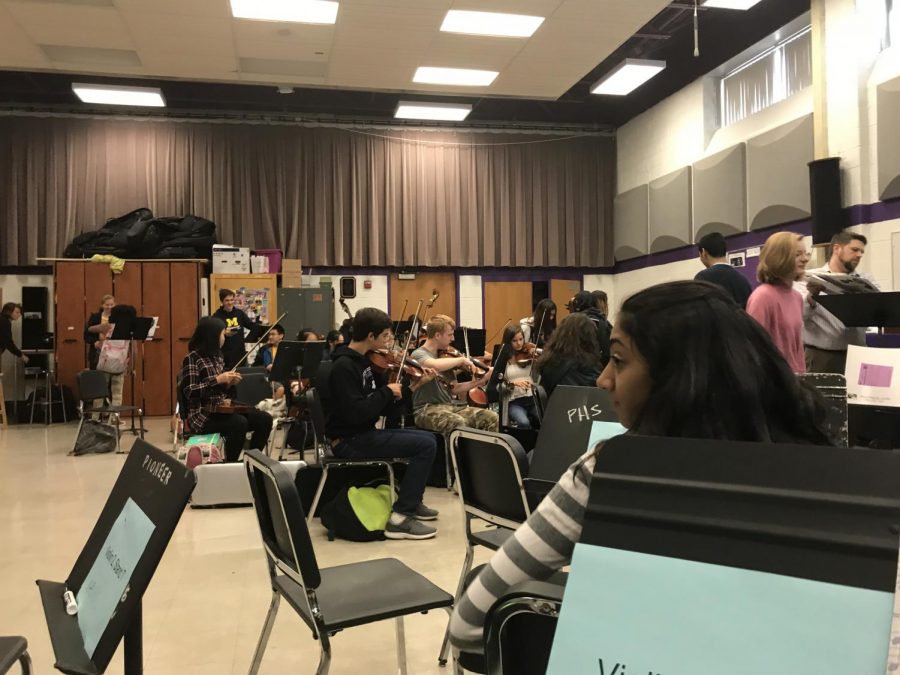Treble-some numbers cause orchestra and choir to expand their programs
Students prepare for class in Symphony Orchestra.
Recently, the music department’s enrollment has drastically increased, causing the choir and orchestra programs to expand. But this kind of expansion isn’t a new idea. According to David Leach, director of bands at Pioneer, the Pioneer bands acted as a trendsetter for a movement that has spread throughout the whole district’s music programs.
“The interesting thing about me moving to purple and white actually [is that it] caused a domino effect, everybody’s done it,” Leach said. “So now, orchestra jumped in and they’re doing purple and white. The Huron orchestra [and band] is doing green and gold…So everyone’s accepted the model that the pioneer bands pioneered two years ago.”
However, the idea of orchestra expanding to four orchestras has been in works for a long time. “It was a decision that I had been contemplating since I arrived here ten years ago,” said Orchestra Director Jonathan Glawe. “There was a noticeable gap in level of musician between philharmonic and concert orchestra and I was finding students were struggling with that leap to go from phil to concert; and I just kept thinking ‘there’s some great music and some great people that are being lost in the shuffle here; and the natural progression for coming out of our Philharmonic ensemble was missing, pedagogically as well.”
But at the time the numbers didn’t allow for four orchestras. After ten years of waiting, however, the time finally came. “Ten years ago we only had 146 orchestra students,” he said, “so, when we showed up last year with 217 or 218 [I knew] it was time.”
Just like the orchestra, the choir also received an enormous increase in students that caused them to create more choirs. “Our enrollment went up by 34 students between last spring and May to current, and the original enrollment had actually gone up by 50,” said choir director Steven Lorenz.
However, the logistics behind the choir’s expansion of its program are a little different: unlike band and orchestra did not add another tiered ensemble, but instead split an ensemble into two sections. “The students didn’t audition in March with the anticipation of having two levels,” Lorenz said. “We didn’t know that when they auditioned back in March that we were going to need two levels.”
In doing this, however, Choir has reached a “win-win” situation. “It gives us more individual time with students and it also allows for more flexibility in schedules which is always a challenge for students,” said Lorenz.
As for what the students think? It’s mostly a positive opinion.
According to senior Nora Pluth, the band’s more pedagogically sound arrangement improved her experience in band. “At first [it] was kind of disheartening because I wanted to be in the top band for as long as I could; but looking at it now, I think that the multiple levels helped me make the transition a little easier into symphony band,” she said.
However, the change does come with its challenges. According to senior and concert white co-secretary Chris Novak, the transition has left some uncertainty in the orchestra. “Concert white is still trying to figure out what it is and is not within our ability to play,” Novak said. But ultimately, he thinks that the change makes orchestra better from how it had been previously. “Playing in concert orchestra last year with 93(ish) people was hard,” said Novak. It was “hard to figure out specific issues and [it] was hard to find a place to sit.”
Concert white co-president, Anna Goforth agrees. “It’s a bit of a learning experience but we have people on council who have been in Orchestra for 3 or 4 years now so we have experience with how orchestra works and are now trying to find the identity of this orchestra,” she said.
As for choir, they have their own changes. But the consensus seems to be the same: it might be hard now, but the program will ultimately fix the bugs and will be better because of the change. “As of right now we’re trying to figure out exactly how to make things go smoothly,” said co-head librarian Ayla Hoermann. “I think the biggest challenges are going to be when they have to come together as a group since they’ll be singing the same songs, but adding in other people, and they might have to get used to different teachers conducting style for certain pieces; but they’re all very capable singers so they don’t think it’ll be very challenging for them.”


